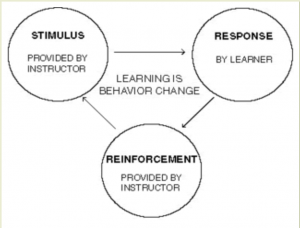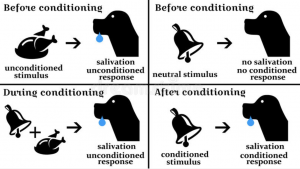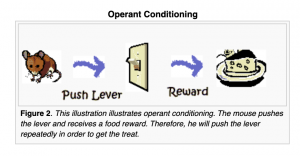7 Chapter 7: Behaviorism

The focus of this chapter is Behaviorism. This educational philosophy is based on the belief that human behavior can be explained based on response to external stimuli. When translated into a classroom setting, Behaviorists believe that the best educational environment can be obtained when student behavior is shaped by arranging specific conditions for learning.
To better understand Behaviorism, this chapter will provide an overview of the key characteristics of Behaviorism. Information related to how this philosophy of education is reflected in the curriculum and its instructional methods will also be presented. Within this presentation, a discussion of the role of the teacher and role of the learner will be discussed. Finally, key proponents of Behaviorism and their contributions to this philosophy of education will be presented.
Characteristics of Behaviorism
7.1 Essential Questions
By the end of this section, the following Essential Questions will be answered:
- What are the philosophical foundations of Behaviorism?
- What are some of the educational implications of Behaviorism?
- What are some examples of Behaviorism in the classroom?
When you hear the term “Behaviorism,” what comes to mind? For many people, the first thing that comes to mind is shaping behavior in response to a specific stimuli. In the classroom, Behaviorism is often linked to “rewards” or positive reinforcement.
According to Zirpoli (2005), the basic principles or philosophical foundations of behaviorism are as follows:

- Most behaviors are learned.
- Most behaviors are stimulus specific.
- Most behaviors can be taught, changed, or modified.
- Behavior change goals should be specific and clearly defined.
- Behavior change programs should be individualized.
- Behavior change programs should focus on the here and now.
- Behavior change programs should focus on the child’s environment (p. 13).
As demonstrated by these philosophical foundations, Behaviorism is focused on the study of observable behaviors.
7.2 A Closer Look
For a brief overview of the foundations of Behaviorism and its current impact on educational practices, please watch the attached “Behaviorism” video. While watching the video, think about the Questions to Consider to enhance your understanding of the video.
- How was behaviorism a change from other theoretical perspectives?
- Who were two key researchers in behaviorism and what specifically did they contribute?
- What is the application of Behaviorist instruction in the classroom referred to?
- What are some examples of direct instruction in the classroom?
- In a classroom using behaviorism, is instruction student-centered or teacher-centered? Why?
Curriculum
7.3 Learning Objectives
By the end of this section, the following Essential Questions will be answered:
- What is the focus of the curriculum in a Behaviorist classroom?
- What are the key elements of the curriculum in a Behavioristic approach to instruction?
- Do you think the focus of this curriculum is beneficial for students? Why or why not?
The focus of the curriculum in a Behaviorist classroom is not the curriculum itself. Rather, it is on the environmental variables within the classroom (i.e., the teaching materials, instructional methods, and teacher- classroom behaviors), as each of these variables directly influence the learner’s behavior (Witrock, 1987). An example of an environmental variable would be the disciple plan. As demonstrated in the picture below, this behavior chart outlines what the behavioral expectations are for the students in the classroom. In order to stay “blue,” the students need to be following all the rules of the classroom and be behaving in an amazing manor. “Green” indicates that students are following the rules of the classroom as expected and doing a great job. “Yellow” shows that the student gets a warning for not following one or more of the classroom rules and needs to get back on track. “Orange” means that the student gets a time out. Finally, “red” means that the student looses a privilege.

Curriculum design
In a Behaviorist classroom, curriculum is designed in a very prescriptive manner. The reason for this is that students are expected to master the curriculum being presented. To help students achieve mastery, instruction is presented in a step-by-step approach.
Step One: A stimulus is provided by the teacher.
Step Two: The learner responds to the stimulus.
Step Three: Reinforcement is provided by the teacher.
As demonstrated in the steps above, curriculum is defined by learning and behavior change in a behaviorist classroom. When creating curriculum, the teachers focus is on results. To see if results are met, the teacher carefully analyzes student outcomes. If outcomes are not met, more programed instruction is implemented to achieve desired behaviors.
7.4 A Closer Look
For a more in-depth look at behaviorism in the classroom, please read the following article titled: Behaviorism. As you are reading, consider the following questions:
- What was one researcher discussed in the article? What was the name of his experiement? In what ways did his experiment contribute to Behaviorism?
- How does Behaviorism impact classroom management? Have you seen an example of this in real classrooms? Please provide a brief overview from your own experience.
- What is PBIS? Do you think this would be effective in the classroom? Why or why. not?
- What is one insight you gained about Behaviorism from the article?
- Do you agree with the “cons” outlined about Behaviorism? Why of why not?
Instruction in the Classroom
7.5 Essential Questions
By the end of this section, the following Essential Questions will be answered:
- What are the main methods of instruction in a Behaviorist classroom?
- What is the teachers role in the classroom?
- What is the students role in the classroom?
- What strategies do students use in Behaviorist classrooms?
As previously stated, the Behaviorist theory of instruction is focused on providing reinforcement for behaviors that have been identified as appropriate for the learning environment. To achieve these behaviors, a variety of instructional methods can be applied. The key is to make sure that any instructional method that is implemented can be observed and measured. For example, students might work on the computer so that they receive immediate feedback and reinforcement.
7.6 A Closer Look
- In Figure 1.Assumption of Teacher and Student Roles and Responsibilities, the authors identified four main categories to consider. Do you think one of these is more important than the other? Why of why not?
- What is one of the roles that teachers take on as described in the article? What is the main focus of this role?
- What is one of the roles the students take on as described in the article? What is the main focus of this role?
- What is one thing teachers should consider about classroom environment? Have you see this in classrooms you have been in? If so, please elaborate. If not, please come up with an example for your future classroom.
Standridge (2002) identified the following behaviorist techniques which have long been employed in classrooms across the country to promote positive behavior and discourage behavior that is undesirable:
- Behavioral Contracts: Simple contracts can be effective in helping children focus on behavior change.
- Consequences: They can occur immediately after a behavior and may be positive or negative, expected or unexpected, immediate or long-term, extrinsic or intrinsic, material or symbolic (a failing grade), emotional/interpersonal or even unconscious.
- Positive reinforcement: The presentation of a stimulus that increases the probability of a response (i.e., smiling at students after a correct response).
- Negative reinforcement: Increased probability of a response that removes or prevents an adverse condition (i.e., perfect attendance is rewarded with a “homework pass”).
- Punishment: Involves presenting a strong stimulus that decreases the frequency of a particular response (i.e., students who fight are immediately sent to the principal).
- Extinction: Decreases the probability of a response by contingent withdrawal of a previously reinforced stimulus (i.e., a teacher gives partial credit for late assignments; other teachers think this is unfair so the teacher decides to then give zeros for the late work).
Teachers Role
The teacher is the center of instruction in the Behaviorist classroom. It is his or her role to ensure that the classroom is properly managed in order to ensure that student learning can take place. According to research by Emmer (1987), there are two general management principles that a Behaviorist teachers must follow in the classroom:
- Identify expected student behavior so that behaviors that are appropriate and inappropriate are identified before instruction begins.
- Translate expectations into procedures and routines by creating basic rules of conduct for the classroom.
In addition to these two general management principles, other roles of the teacher include: monitoring classroom events, timely and accurate addressing of inappropriate behavior, apply a reward and accountability system, creating a checklist for completed assignments, and monitoring class participation/engagement (Emmer, 1987).
All of these roles require skill on the part of the Behaviorist teacher in order to implement successfully. For example, the teacher needs to know about educational psychology in order to establish an appropriate behavioral reward system in the classroom (Webb et. al., 2010). This includes knowing what would be appropriate reinforcers and how best to set up a proper schedule of reinforcement. Since Behaviorism also emphasizes empirical verification, teachers must also be trained in the scientific method (Webb et. al., 2010).
These systems of student monitoring and tracking are used in many classrooms across the country today. Particularly for students on Instructional Education Plans (IEPs) who many need more one-on-one monitoring and feedback. Which is why behaviorist teachers are sometimes referred to as “the controllers of behavior” and the “arrangers of contingencies” (Webb et. al., 2010, p. 80). No matter what name they are assigned, teachers applying this philosophy of education have a very big responsibility when it comes to classroom and student management.

- Do you think the level of classroom management outlined by Behaviorists is really necessary? Why or why not?
- If you had to set up a Behaviorist classroom, what type of reinforcements would you use? Why?
Students Role
According to research by Webb et. al. (2010), the behaviorist philosophy assumes the following two things about students:
- First, every student is capable of, and predisposed too, modifying or changing his or her behavior.
- Second, every student is capable of learning new behavior.
Based on these two assumptions, the students role is to learn to modify or change a learned behavior based on the introduction of specific stimuli from the teacher.
The students success is measured via specified “behavioral objectives (e.g., the behaviors of knowledge that students are expected to demonstrate or learn) that are observable and preferably measurable” (Webb et. al., 2010, p. 79). For students, better classroom performance is achieved through behavior modification when the following six basic components are in place:
- Clear articulation of the desired outcome including stating what students must changed and how behavior will be evaluated. For example, increased student participation in class discussions as measured by tally marks teacher notes each time a student participates in class.
- Development of a positive and nurturing environment where students feel safe and comfortable. For example, calling on a student to share an answer when you know they can successfully provide the correct answer.
- Identification and application of appropriate intrinsic and extrinsic rewards. Note – each student may require a different type of reward.
- Reinforcement of desired behavior until the student is able to independently apply behaviors in class.
- Gradual reduction of rewards so the student does not require them to display desired behaviors.
- Evaluation and assessment of behavior modification techniques to ensure teacher expectations and student results are what are desired (Brewer, Campbell, & Petty, 2000).

- Do you believe every students is capable of, and predisposed to, modifying of changing his or her behavior? Why or why not?
- How important do you think it is to have behavioral objectives?
Key Proponents
7.7 Essential Questions
By the end of this section, the following Essential Questions will be answered:
- Who were the key proponents of Behaviorism?
- What impact did each of the key proponents of Behaviorism have on this philosophy of education?
The roots of Behaviorism can be traced back to the early 20th century. Among the key philosophers who influenced the development of Behaviorism were Ivan Pavlov, John W. Watson, and B.F. Skinner. In this section, a brief overview of each of these philosophers and their contributions to the philosophy of behaviorism will be presented. As you read about each one and watch the video clips providing additional information for many of the researchers presented here, critically reflect on the similarities and differences among them. Specifically, see if you can identify any overarching themes between them.
Ivan Petrovich Pavlov (1849 – 1936)
Russian physiologist and psychologist, Ivan Petrovich Pavlov, is best known for his experiment in which he trained a hungry dog to drool at the sound of a bell.

However, an interesting fact about his research is that Pavlov’s initial study was only focused on the interaction between the amount of saliva dogs produced and their digestive process (Standridge, 2002). It was only when he was conducting his study that he found the dogs began to salivate before they received their food. Finding this to be very interesting, Pavlov decided he to determine if an external stimuli such as a bell being sounded would also cause the dogs to salivate. Training the dogs to respond to the bell resulted in what Pavlov called a “conditioned stimulus,” and the dogs salivation was the “conditioned response” (Standridge, 2002).
7.8 A Closer Look
For more information on Ivan Petrovich Pavlov and his groundbreaking research, please watch the following video clip. As you watch, use the Questions to Consider that have been posed about his work and the implications of his research on the field of behaviorism.
- How did Pavlov determine that the dogs were responding to the stimulus before it was being introduced?
- What did Pavlov do to test his hypothesis?
- What did Pavlov do after introducing the bell? How can Pavlov’s work be applied to the classroom?
- In what ways do you think Pavlov’s work shaped the philosophy of Behaviorism?
As shared in the video, Pavlov’s experiments demonstrate three major tenets of the field of behaviorism:
- Behavior is learned from the environment: The dogs only learned to salivate when they heard a specific stimulus and then were presented the same stimulus along with food multiple times.
- Behavior must be observable. Pavlov was able to demonstrate his findings because he was able to observe the dogs salivating in response to a specific stimulus.
- All behaviors are a result of both stimulus and response. The stimulus would cause no response in the dogs until it was associated with the presentation of food, to which the dogs naturally responded with increased saliva production ( , & 2022, p. 1).
As a result of his research, Pavlov won the 1904 Nobel Prize for Physiology or Medicine.
John B. Watson (1878 – 1958)
Building on the work of Pavlov, Watson argued that the process of classical conditioning was able to explain all aspects of human psychology. In fact, he argued that individual differences in behavior were simply due to different learning experiences (McLeod, 2014). Based on this belief, he was once quoted as saying:
“Give me a dozen healthy infants, well- formed, and my own specified world to bring them up in and I’ll guarantee to take any one at random and train him to become any type of specialist I might select – doctor, lawyer, artist, merchant- chief and, yes, even beggar-man and thief, regardless of his talents, penchants, tendencies, abilities, vocations and the race of his ancestors” (Watson, 1924, p. 104).
Perhaps best known for his “Little Albert experiment,” Watson set out to demonstrate how specific learning experiences could shape an individuals behavior in 1920. This experiment involved testing baby Albert, a 9-month-old infant, and his reactions to various stimuli. Working with his partner, Watson and Rayner observed little Albert’s reactions and noticed that he was not adversely affected to different stimuli. However, when the a specific stimuli (a white rat) was paired with a sudden loud noise, little Albert got startled and began to cry. By conditioning little Albert to fear the white rat through repeated pairing of the rat with the noise, Watson and his partner were able to demonstrate classical conditioning could be used to create a phobia (McLeod, 2014).
7.9 A Closer Look
Please watch the following video clip which presents an overview of the experiment. As you watch the video, use the Questions to Consider as a guide.
- How ethical do you think this experiment was?
- What did you learn about classical conditioning as a result of this experiment?
- Do you think an experiment this would be allowed today?
- What are the implications of Watson’s research on Behaviorism?
The Little Albert experiment would not be considered ethical today. However, the experiment did demonstrate that by controlling Albert’s environment his behavior changed. Thus demonstrating that learning had occurred.
B. F. Skinner
Skinner is best known for the concept of operant conditioning. Based on hisexperiment with the Skinner box, Skinner was able to determine the following:
- Operant conditioning is the rewarding of part of a desired behavior or a random act that approaches it.
- An operant response would be pressing a bar to receive a food pellet.
- A reinforcer is the food pellet itself.
- A punisher is the consequence that suppresses a response and decreases the likelihood that it will occur in the future (i.e., receiving an electric shock for pressing the bar to receive a food pellet).
Skinner is quoted as saying: “the things we call pleasant have an energizing or strengthening effect on our behavior” (Skinner, 1972, p. 74). Through Skinner’s research on animals, he concluded that both animals and humans would repeat acts that led to favorable outcomes, and suppress those that produced unfavorable results (Shaffer, 2000). The following visual, buy Standridge (2002), demonstrates the concept of operant conditioning.

In other words, we are who we are based on the operant conditioning we have received. Consequently, Skinner believed that an individual persons behavior could be shaped or conditioned if the right operant responses and reinforcements were utilized.

Reflect on your learnings about Behaviorism! Write down three things you learned about this philosophy of education, two things you found surprising, and one professional connection you can make to your future professional practice.
References
, , & (2022). Behaviorism. In (Ed.), Education Research. EdTech Books. https://edtechbooks.org/education_research/behaviorismt
McLeod, S. (2014). Classical Conditioning. Common Lit. https://www.commonlit.org/en/texts/classical-conditioning
Standridge, M.. (2002). Behaviorism. In M. Orey (Ed.), Emerging perspectives on learning, teaching, and technology. Retrieved March, 2022, from http://epltt.coe.uga.edu/
Media Attributions
- Ch 6 Intro Quote © Mocah HD Wallpapers
- Behaviorism Characteristics Pic © Chia Yee Yong
- Behavior Chart © MainlyCharts
- Stop and Think © DWRose
- Classical Conditioning © dreamstime
- Screen Shot 2022-04-26 at 11.11.39 PM
- Brainstorm

